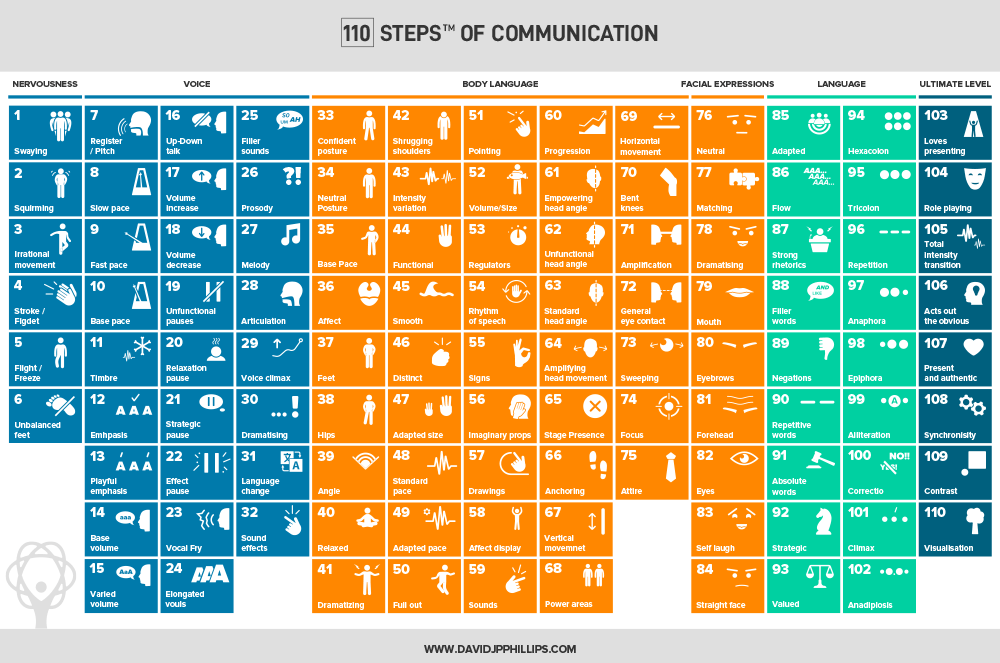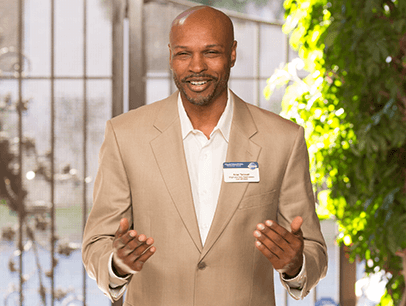 David JP Phillips’ matrix of the 110 speaking skills can also be found at www.davidjpphillips.com.
David JP Phillips’ matrix of the 110 speaking skills can also be found at www.davidjpphillips.com.Click play to hear the hosts of The Toastmasters Podcast interview the author, David JP Phillips, about how he came up with his 110 core speaking skills.
Why is she tilting her head when listening? Why does he stand stiffly while speaking? Why did he step backward when asking the audience a question?
I had been a public speaking coach for about eight years when I started noticing patterns in peoples’ speaking behavior. I saw that when having everyday conversations, leaders, speakers, and salespeople often displayed common behaviors—both good and bad. I started to wonder why, and to consider whether changing these behaviors would render different results in communication.
I began the journey of writing down the positive characteristics, which I came to call “skills.” After about seven years and 5,000 speakers, I was able to distill these behaviors into 110 core skills—and even more subskills that wonderfully bolstered and supported the development of communication. These subskills represented various features, such as different ways to make sounds with your mouth, like clicking and whistling. I categorized these under the skill of creating sound effects.
I began noticing other useful behaviors. For example, the skill of dramatization, which combines using words effectively with subskills like singing, roleplaying, screaming, and any extreme vocal characteristics.
So there I was, with 110 core skills and hundreds of subskills, and my dream was coming true. My aim was to coach more people and deliver better results, and I started to develop my 110STEPS course. Suddenly, I knew how to resolve challenges my clients were facing, such as, “I don’t get questions after my presentation—what should I do?” I could advise my client to use an empowering head angle, a skill that involves tilting your head to the left or right to show that you care about any and all audience questions.
I could also share insights into handling questions from the audience. One example: Combine the above skill with empowering head movement, like nodding and affirming people’s questions while listening. Also: If you know the answer, don’t answer immediately—credit the person for asking a good question by moving your eyes upward or downward to signal that the answer needs some consideration before responding. Just like that, my client started receiving more questions every time they presented. These behaviors signaled that they truly cared about the questions and could effectively deliver answers.
I was able to clearly define and guide my clients with core skills that represented the fundamental building blocks of their personal communication. In addition, I had discovered that not only were there 110 core skills, but there were also three interesting layers that emerged from the research.
1 Skill-Chains
The concept that certain skills benefit from being launched in a particular sequence is a skill-chain. For example, here’s a skill-chain that is powerful when ending a talk, or when you need to generate absolute attention: You start moving toward the audience, you lower your body, slow down the pace of your words, switch to a soft timbre, lower your volume of speech, focus your eyes, and launch an effective pause as the audience drools, patiently waiting in anticipation of your final words. Combining these seven specific skills will create a wonderful effect and keep your audience’s focus.
2 Interconnected skills
The second layer refers to interconnected skills, meaning one particular skill directly impacts several other skills. I consider these more focused skills “mother skills” since many others branch off from this starting point. A clear example of this is the skill of base volume, which is the volume you generally speak at, from which you can either increase volume or lower it. This would impact over 21 other skills, like confident posture, distinct gestures, and sweeping eye movements. If a speaking coach doesn’t know about these interconnected skills, they would coach the person in those 21 individual skills, which would be a waste of time because the mother of these interconnecting skills is base volume. The mother skill is the answer to effective coaching. A few other important mother skills to mention are eye focus, horizontal movement, and functional gestures.
3 Synchronicity
Imagine walking into a room, meeting a person you have never met before, yet enjoying their presence. You feel relaxed and are able to open up instantly and with great ease. Now imagine the same room and meeting a person who you just don’t like or trust. You are not sure why, but you are unable to connect with them and you feel uneasy. This speaks to the third layer I discovered, which has to do with synchronicity. It comprises five levels: body language, facial expressions, voice, gestures, and words. When all five levels of communication are aligned to help you deliver one message, you achieve ultimate synchronicity. These five layers will dictate the ways in which you connect with others and the theory is simple: It is important to effectively use all of the layers, otherwise, you won’t fully connect with your audience. To master the five layers of synchronicity, practice until they are an extension of yourself and speak with emotion to enhance it further.
So as with all systems, we have to ask the question: What are the flaws of the model? While there are great advantages, the model cannot be used on everybody. Once in a while, you see a person who has a truly unique style, and that style and behavior should never be changed. It also isn’t accurate to say that the model molds all speakers to present the same way. Everyone has unique characteristics, expressions, and personalities that blend into the 110 skills in different ways—rendering unique results. Understanding how to use these characteristics should help you refine your skills, ensuring that you convey your message clearly and creatively.
What’s the next step for you? Look at each of the characteristics and begin to systematically practice each skill until you achieve fluency in each one. Practice it in your everyday life so that when you are onstage, it becomes second nature to you.
Irrespective of which path you take, becoming an excellent public speaker requires careful consideration of individual skills and identifying your greatest strengths while being mindful of your greatest potential. This will set you apart and allow you to deliver a powerful message.
David JP Phillips is the founder of HeadGain Academy and a TEDx speaker. He presented on his 110 skills at the 2021 Toastmasters Convention. You can connect with him at www.headgain.com and on LinkedIn, YouTube, and Instagram.
Related Articles

Stage Presence
The Power of Body Language

Presentation Skills
What a Nice Gesture!

Presentation Skills



 Previous
Previous

 Previous Article
Previous Article